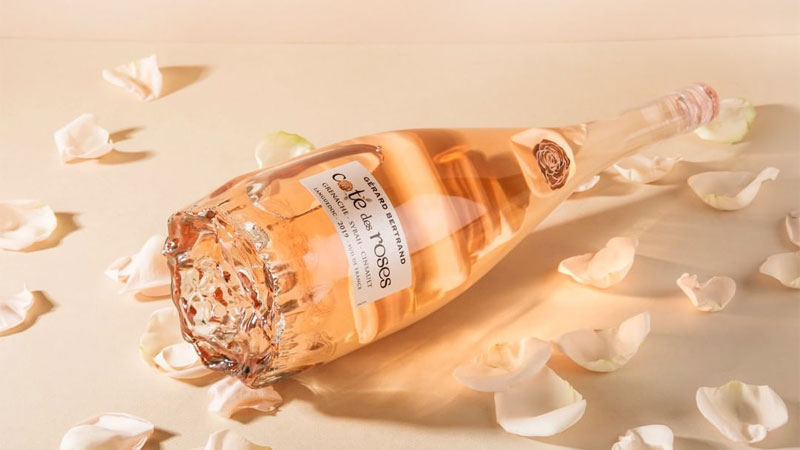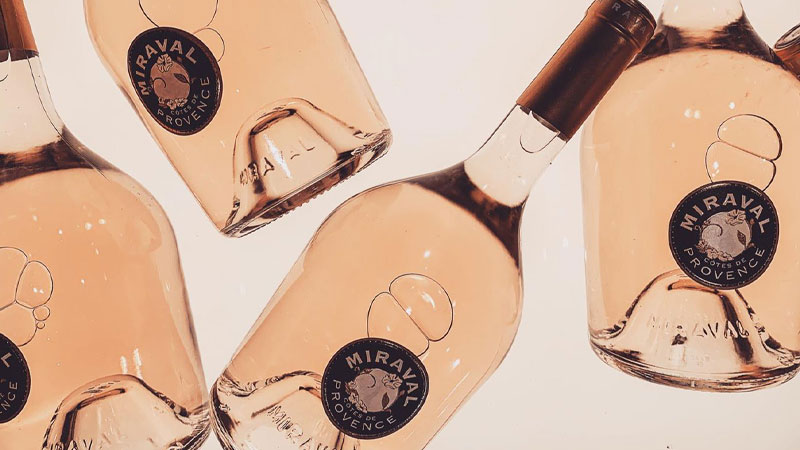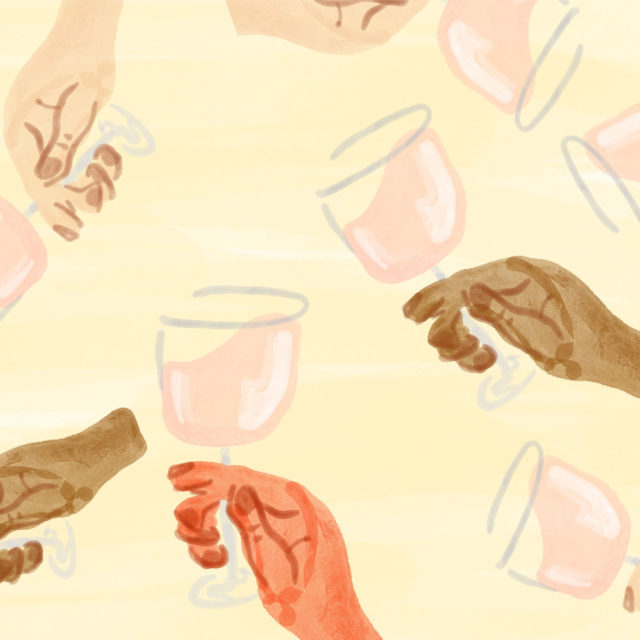Rosé is the fastest growing major wine category of the last few years. According to Nielsen, off-premise sales of rosé in January 2016 were valued at about $151 million. As of January 2020, they rose to over $576 million — a 281 percent increase.
Provence rosés are still considered the traditional style, and many producers around the world emulate Provence’s pale salmon-colored wines. But in recent years, other styles have been gaining traction, too. To get a better sense of what consumers are seeking when they decide to drink pink these days, we reviewed the most popular rosés on Wine-Searcher.com in both the crisp and dry style and the rich and fruity style.
Based on search frequency on the company’s site, the 10 most popular rosés on Wine-Searcher are:
1. Château Miraval Côtes de Provence ($22)
2. Mateus Portugal The Original ($6)
3. Frank Cornelissen Etna Susucaru ($31)
4. Château d’Esclans Côtes de Provence Whispering Angel ($22)
5. Gérard Bertrand Languedoc Côte des Roses ($14)
6. R. López de Heredia Viña Tondonia Rioja Rosado Gran Reserva ($108)
7. Château Minuty Côtes de Provence M de Minuty ($17)
8. Domaine Tempier Bandol ($40)
9. Domaines Ott Bandol Château Romassan ($37)
10. Vanderpump Côtes de Provence ($19)
What can we learn from this list?
The Old Standbys Prevail, but the Category Is Expanding
Of the wines on this list, seven are from France and six are from Provence, so French rosés — and those from Provence in particular — still reign supreme, notably with Côtes de Provence-based bottlings like Château Miraval’s Côtes de Provence rosé at No. 1 on the list, Whispering Angel by Château d’Esclans at No. 4, and Château Minuty’s M de Minuty at No. 7. But interest is broadening geographically.
Wine-Searcher’s fifth most popular rosé, Gérard Bertrand’s Côte des Roses, is produced farther down the Mediterranean Coast in the Languedoc region. Wines from Languedoc yield some similar southern French characteristics, but the region hasn’t received as much recognition for its rosés as its neighbor to the north. “Rosé is a booming category, and when it comes to the south of France, the Languedoc has all the assets to elaborate fabulous rosé wines,” says Laura Coulon, a press relations manager at Gérard Bertrand. “The spontaneous success of Côte des Roses has proven it.”
Rosé wines from Portugal, Italy, and Spain also made the list, coming in as the second, third, and sixth most popular, respectively. This shows that people are willing to move beyond the category’s most traditional wines and experiment with a more diverse range of styles, flavors, and shades of rosé.
“At Rosé Mansion we pour wines from all over the world, and we have seen very little, if any, brand loyalty to Provence,” says Tyler Balliet, a co-founder with Morgan First of Rosé Mansion, an expansive exhibit and rosé wine experience in New York. “People are more drawn to a taste profile and good storytelling.”
Devon Broglie, a Master Sommelier and global beverage buyer at Whole Foods, says he sees similar wines as the ones on Wine-Searcher’s top 10 list trending at Whole Foods stores. “[It] is a well-rounded list,” he says, adding that “rosé sales continue to be very strong at all price points and from all countries, including domestic [U.S.] and Southern Hemisphere rosés. He also says that while it isn’t surprising to see Provençal rosés dominating the list, “seeing wines from Italy and Spain is promising — and it’s always fun to see Mateus [from Portugal] making a comeback.”
Anthony Lynch, an importer at Kermit Lynch Wine Merchant in Berkeley, Calif., says he’s encouraged by this diversity in rosé. “I see it as a first step toward rosé being treated equally to red and white wines,” says Lynch. “That is, judged for sense of terroir and winemaking savvy, rather than color and price.”

Premium Rosé Is Staking a Place in the Market
The majority of wines on Wine-Searcher’s top 10 list are in the drink-now camp, but there are four higher-end rosés that exemplify consumers’ willingness to spend a little more on premium offerings. Two of the Provençal wines are from Bandol, a small subregion that promotes the production of more serious — sometimes age-worthy — rosés based on the Mourvèdre grape. Domaine Tempier and Domaines Ott’s Château Romassan, both blends of Mourvèdre, Grenache, and Cinsault, are good examples of these styles.
The other two high-end offerings are from outside France. Frank Cornelissen’s Susucaru from Sicily is a blend of Malvasia, Moscadella, Insolia, and Nerello Mascalese. It typically costs around $30. R. López de Heredia’s Viña Tondonia from Spain is made with Garnacha, Tempranillo, and Viura. The current Gran Reserva vintage on the market is 2009. At just over $100 a bottle, the Viña Tondonia has a much heftier price tag than any of the others on the list.
“More and more people are open to the idea of a higher-end rosé,” says Lynch, whose company imports Tempier. “But there is still a long way to go here. Rosé as a category is treated more like a generic beverage and less like a fine wine.” He adds that the market for fine rosé has paralleled the growth of the category overall, but that the average consumer will still only pay so much for a bottle of rosé.
Chevalier explains that the brand expanded in part by courting consumers at events, such as wine festivals, private dinners, sailing regattas, and polo matches. “In the U.S., the wine consumer has changed enormously in the last 50-odd years,” he says. “It went from a consumer in the 1960s that did not drink wine at all … [to] now, we’re in 2020 — we have this whole new generation, the millennials, who were the first generation to grow up with their parents drinking wine.” Because this demographic was exposed to wine early on, he says, it created an open-mindedness that’s “enabled us to spread the word about Whispering Angel.”
People Aren’t Afraid of Offbeat Styles
Many of the rosés on this list are pretty mainstream, but there is clearly some interest in offbeat versions, too. For example, the Sicilian Susucaru is a juicy, natural rosé that’s quite dark in color. The Spanish Viña Tondonia is the color of onion skin and aged in oak barrels for four years, which gives it a more complex flavor profile than the average rosé.
Balliet says the most popular rosés at Rosé Mansion are sweet and semi-sweet, but there’s a willingness to experiment within these styles. He points out that one of the top three selling wines at the bar is a Brachetto, a lesser-known, slightly fizzy, and sweet wine from Piedmont in northwestern Italy.
While not exactly “offbeat,” another consistent style preference in rosé is blends. On the Wine-Searcher list, all but two of the wines are blends. This could be attributed to the fact that most rosés are made from blends, but it may also suggest that consumers don’t necessarily view the product through the context of grape variety (or varieties) the way they might in other types of wines.

Balliet says Dr. Konstantin Frank’s Pinot Noir rosé from the Finger Lakes region of New York is very popular at Rosé Mansion, but it’s about the only monovarietal rosé to really see some movement. “We pour a lot of blends and weird grapes,” he says.
Shaw-Ross’s Chevalier suggests that because producers are limited by the varieties available in their countries and regions, they often don’t have much choice about which grapes they can use for making rosés. “Grenache enables you to achieve the more elegant, lighter, more delicate styles of rosé,” he says. “You cannot achieve that from Cabernet Sauvignon, Malbec, [or] Sangiovese.” The thicker skins, he adds, make “dark and tannic” rosés, a style that doesn’t interest most consumers.
Celebrity Has a Role to Play in Sales
Even though actors Angelina Jolie and Brad Pitt split up, the Provençal wine brand they started with star Rhône vintner Marc Perrin, Château Miraval still tops this list. The brand has staying power. The legacy of the celebrity couple’s backing and the quality of the wine seem to have locked in loyal fans.
The last wine on Wine-Searcher’s list is also a celebrity brand. Vanderpump rosé was founded by reality TV star Lisa Vanderpump — who got famous from her appearance on “The Real Housewives of Beverly Hills” and later started her own show, “Vanderpump Rules.” She launched her rosé brand in 2017.
At Rosé Mansion though, where you’d think there might be a greater interest in celebrity rosés, stars don’t have much sway. “We don’t really carry any celebrity rosé — and very few people ask for any,” says Balliet, “so I would say [there’s] very little interest.”
Overall, Wine-Searcher’s list confirms trends that have been observed in the rosé market for some time now — most notably, the popularity of certain brands and the dominance of the pale-pink Provençal style. But it also hints at a growing consumer interest in branching out, both geographically and stylistically — as well as a willingness to spend a little more for premium pinks.
This story is a part of VP Pro, our free platform and newsletter for drinks industry professionals, covering wine, beer, liquor, and beyond. Sign up for VP Pro now!
